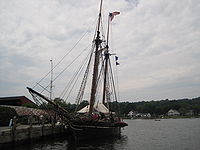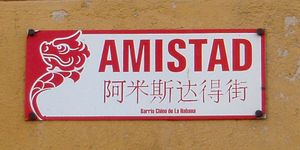La Amistad
| |
This article needs additional citations for verification. Please help improve this article by adding reliable references. Unsourced material may be challenged and removed. (December 2008) |
La Amistad (Spanish: "Friendship") was a ship notable as the scene of a revolt by African captives being transported from Havana to Puerto Principe, Cuba. It was a 19th-century two-masted schooner built in the United States, but owned by a Spaniard living in Cuba. The Africans took control of the ship in July 1839 and were captured off the coast of Long Island by the USS Washington of the United States Revenue Cutter Service. La Amistad became a symbol in the movement to abolish slavery. The ship was taken under control by the United States, resulting in a US Supreme Court case (1841) over the status of the Africans, as importation of slaves into the US had been prohibited since 1808.
Contents
The incident
The rebellion at sea
| Wikisource has original text related to this article: |
On July 2, 1839, Sengbe Pieh (later known in the United States as Joseph Cinqué) led 56 fellow Africans (52 adults and 4 children), the captives being transported aboard La Amistad from Havana, in a revolt against their captors. In the main hold below decks, the captives found a rusty file. The captives freed themselves, and they quickly ascended the stairs to deck. Armed with machete-like cane knives,[1] they were successful in gaining control of the ship and demanded to be returned home. The ship's navigator, Don Pedro Montez, deceived them about which direction their course was on and sailed the ship north along the North American coast to the eastern tip of Long Island, New York. The United States Revenue Cutter Service discovered the schooner and took it and its occupants into custody. They took the Africans to Connecticut to be sold as slaves.
Court case
A widely publicized court case ensued in New Haven, Connecticut, about the ship and the legal status of the African captives, which became a cause célèbre among abolitionists in the United States. At the time, the transport of slaves from Africa to the Americas was illegal, so the ship owners fraudulently described the Africans as having been born in Cuba. The court had to decide if the Africans were to be considered salvage and the property of Naval officers who had taken custody of the ship, whether they were the property of the Cuban buyers or of Spain as Queen Isabella II of Spain claimed, or if the circumstances of their capture and transportation meant they were free.
On appeal, The Amistad case reached the US Supreme Court, which in 1841 ruled in that the Africans had been illegally transported and held as slaves, and ordered them freed.
Return to Africa
The Amistad survivors returned to Africa in 1842.
The ship
La Amistad was a 19th-century two-masted schooner of about 120 feet (37 m). Built in the United States, La Amistad (Spanish for 'friendship') was originally named Friendship but she was renamed after being purchased by a Spaniard. Strictly speaking, La Amistad was not a slave ship; she was not designed to transport large cargoes of slaves, nor did she engage in the Middle Passage of Africans to the Americas.
La Amistad engaged in shorter, coastal trade. The primary cargo carried by La Amistad was sugar-industry products, and her normal route ran from Havana to her home port of Guanaja. She also took on passengers and, on occasion, slaves for transport. The captives whom La Amistad carried during the historic events had been illegally transported from Africa to Cuba aboard the slave ship Tecora.
More ships
True slave ships, such as the Tecora, were designed for the purpose of carrying as many slaves as possible. The largest slave ships carried up to 400 slaves. One distinguishing feature that enabled this efficiency was the half-height between decks level. Slaves were chained down in a sitting or lying position, but the area was not high enough for people to stand in. The crew of La Amistad, lacking the slave quarters, placed half the captives in the main hold, and the other half on deck. The captives were relatively free to move about, which aided their revolt and commandeering of the vessel.
Later years
After being moored at the wharf behind the US Custom House in New London, Connecticut, for a year and a half, La Amistad was auctioned off by the U.S. Marshal in October 1840. Captain George Hawford, of Newport, Rhode Island, purchased the vessel and then needed an Act of Congress passed to register her. He renamed her Ion. In late 1841, he sailed the ship to Bermuda and Saint Thomas with a typical New England cargo of onions, apples, live poultry, and cheese.
After sailing Ion for a few years, Hawford sold the ship in Guadeloupe in 1844. There is no record of what became of the Ion under her new French owners in the Caribbean.
Other ships with her name
Western Union
This schooner was in 1939 built by Herbert Elroy Arch, Thompson Enterprises, in Key West, Florida for the Western Union Thompson Fish Company and leased by the Western Union Telegraph Company. Used for cable repair between 1939 and 1974, in 1974 she was converted into a passenger vessel. She was used as film vessel La Amistad, and participated in the Opsail 1976 in New York. In 1984 the schooner was sold to Vision Quest National, Ltd. from Philadelphia, renamed New Way and used to redirect troubled youths. She was in 1997 purchased by Historic Tours of America, Key West, and renamed Western Union again. Used for dockside tours, day sailing trips, and special charter, this ship is a National Historic Landmark.
Freedom Schooner Amistad

Between 1998 and 2000, artisans at Mystic Seaport, Mystic, Connecticut built a recreation of La Amistad, using traditional skills and construction techniques common to wooden schooners built in the 19th century, but using modern materials and engines. They christened Freedom Schooner Amistad. The modern-day Amistad is not an exact replica of La Amistad, as the ship is slightly longer and has higher freeboard. There were no old blueprints of the original.
The new schooner was built using a general knowledge of the Baltimore Clippers and art drawings from the era. Some of the tools used in the project were the same as those that might have been used by a 19th-century shipwright while others were powered. Tri-Coastal Marine,[2] designers of Freedom Schooner Amistad, used modern computer technology to develop plans for the vessel.
Bronze bolts are used as fastenings throughout the ship. Freedom Schooner Amistad has an external ballast keel made of lead and two Caterpillar diesel engines. None of this technology was available to 19th century builders.
Freedom Schooner Amistad is operated by Amistad America, Inc., a non-profit organization based in New Haven, Connecticut.[3] The ship's mission is to educate the public on the history of slavery, discrimination, and civil rights. Her homeport is New Haven, where the Amistad trial took place. She also travels to port cities for educational opportunities. The Freedom Schooner Amistad is the State Flagship and Tall ship Ambassador of Connecticut.[4]
Freedom Schooner Amistad has made several commemorative voyages: one in 2007 to commemorate the 200th anniversary of the abolition of the Atlantic slave trade in Britain (1807) and the United States (1808),[5] and one in 2010 to celebrate the 10th anniversary of its 2000 launching in Mystic Seaport.
La Amistad in popular culture
| 40px | This "In popular culture" section may contain minor or trivial references. Please reorganize this content to explain the subject's impact on popular culture rather than simply listing appearances, and remove trivial references. (June 2010) |
| |
This section does not cite any references or sources. Please help improve this article by adding citations to reliable sources. Unsourced material may be challenged and removed. (December 2008) |
On 2 September 1839, a play entitled The Long, Low Black Schooner, based on the revolt, opened in New York City and played to full audiences. La Amistad was painted black at the time of the revolt.
A 1997 film, Amistad, directed by Steven Spielberg, dramatized the historical incidents. Major actors were Morgan Freeman, as a freed black man in New Haven; Anthony Hopkins, as John Quincy Adams; Matthew McConaughey, as an unorthodox, but influential lawyer; and Djimon Hounsou, as Cinque (Sengbe Peah).
Artist Hale Woodruff completed a mural depicting the events resulting from the Amistad revolt. The three-panel Amistad Murals (1938) are on display at the Slavery Library, Talladega College, Alabama, together with other Woodruff murals inspired by African-American history. A depiction of the ship is part of the floor of the library. School tradition prohibits walking "on" the ship.

In honour of the described events, the name "Amistad" was given to a street in Havana.
The song "My Love Is Your Love" by Whitney Houston references the Amistad: "And the chains of Amistad couldn't hold us."
Malice of the hip-hop supergroup Re-Up Gang references La Amistad in his song "20k Money Making Brothers on the Corner", from their mixtape We Got It 4 Cheap, Volume 3: The Spirit of Competition (We Just Think We're Better), with the lyrics: "Big chain around my neck like I’m fresh off The Amistad... We won’t stop ‘till you give us us free."
Rage Against the Machine's song "No Shelter" from the European/Australian/Japanese version of The Battle of Los Angeles calls out Spielberg's account by claiming: "Amistad was a whip, the truth was feathered and tarred Memory erased, burned and scarred." [[The Fray has a song "You Found Me" that has a street corner where he found god named "Amistad" Zack and Miri Make a Porno has the line, "This ain't Amistad", when Zack walks into the coffee shop during a conversation between his boss and an African-American coworker.
Scary Movie makes reference to the ship in a parody of a scene from Titanic. It features a man on a ship claiming "I'm the king of the world!" as if he were on the Titanic, only to reveal him as a slave held on the Amistad.
References
- ↑ Finkenbine, Roy E (2001). "Chapter 13". in Jane Hathaway. Rebellion, Repression, Reinvention: Mutiny in Comparative Perspective. Greenwood Publishing Group. p. 238. ISBN 9780275970109. http://books.google.com/books?id=ks89uKTlg9AC&client=firefox-a.
- ↑ Tri-Coastal Marine
- ↑ Amistad America Inc.
- ↑ STATE OF CONNECTICUT, Sites ° Seals ° Symbols; Connecticut State Register & Manual; retrieved on January 4, 2007
- ↑ "Amistad Sails Into Bristol For Slave Trade Commemorations". Culture24. http://www.culture24.org.uk/history+%2526+heritage/work+%2526+daily+life/race+and+identity/art50181. Retrieved 2009-12-07.
External links
- Amistad: Some historical considerations.
- Amistad Atlantic Freedom Tour - The Official website of AMISTAD America Inc.
- Amistad: Seeking Freedom in Connecticut, a National Park Service Discover Our Shared Heritage Travel Itinerary
| |||||
ar:أميستاد bg:Амистад (кораб) de:La Amistad (Schiff) es:Amistad (barco) fr:La Amistad it:Amistad (nave) nl:La Amistad ja:アミスタッド号事件 no:«La Amistad» pt:La Amistad ru:Амистад (корабль) sk:Amistad (loď) fi:Amistad sv:La Amistad
- Articles needing additional references from December 2008
- Articles with invalid date parameter in template
- All articles needing additional references
- Pages with broken file links
- Articles with trivia sections from June 2010
- Connecticut articles missing geocoordinate data
- All articles needing coordinates
- 1839 in the United States
- Racism
- Individual sailing vessels
- Schooners
- Slave rebellions
- Slavery
- Symbols of Connecticut
- Nautical lore
- Replica ships
- Two-masted ships
- Museum ships in Connecticut
- Mutinies
- Slave ships
- Museums in New Haven, Connecticut
